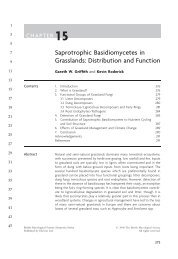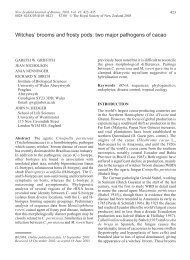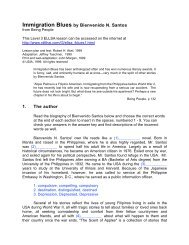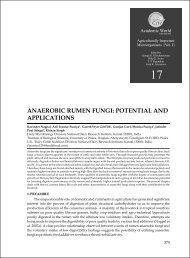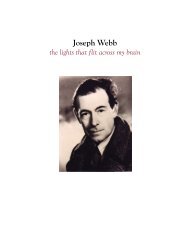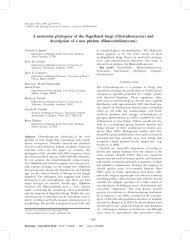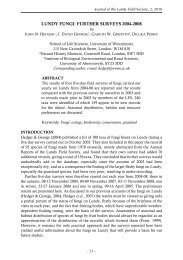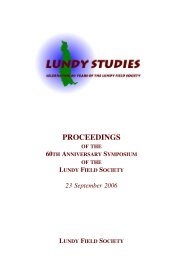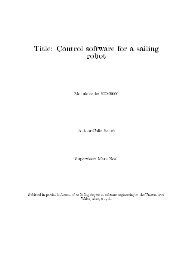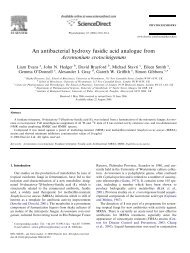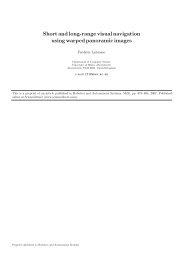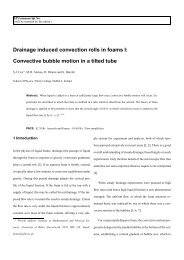Download the pdf - Users Site
Download the pdf - Users Site
Download the pdf - Users Site
Create successful ePaper yourself
Turn your PDF publications into a flip-book with our unique Google optimized e-Paper software.
One of <strong>the</strong> o<strong>the</strong>r features of <strong>the</strong> tall grassland is that <strong>the</strong> higher humidity favours<br />
<strong>the</strong> development of fungal fruit bodies on <strong>the</strong> herbivore dung, which tends to dry out<br />
in <strong>the</strong> short turf areas. Indeed <strong>the</strong> habitual presence of some of <strong>the</strong> Lundy ponies in<br />
a very rushy area near to <strong>the</strong> Quarter Wall gate makes this a productive area to<br />
search for coprophilous fungi. The very large quantities of herbivore dung deposited<br />
everywhere on Lundy are decomposed by specialised coprophilous fungi, many of<br />
which have spores which require passage through <strong>the</strong> gut of a herbivore before <strong>the</strong>y<br />
will germinate. The species list of coprophilous fungi for Lundy remains small only<br />
because of lack of investigation (Hedger & George, 2004). Early colonisers are<br />
microfungi, such as <strong>the</strong> aptly named ‘hat thrower’ (Pilobolus spp.) which forms<br />
glistening mats on relatively fresh horse apples in <strong>the</strong> early morning and discharges its<br />
minute black sporangia onto surrounding grass. Older more decomposed horse dung<br />
is often covered with <strong>the</strong> minute orange disc-shaped apo<strong>the</strong>cia of <strong>the</strong> ascomycete<br />
Coprobia granulata, and also produces large agarics such as <strong>the</strong> handsome eggshaped<br />
capped Anellaria semiovata, and <strong>the</strong> pure white ‘dung inkcap’, Coprinus<br />
niveus. A related coprophilous agaric, Paneolina foenisecii, a small greyish-brown<br />
species with a rounded cap with a distinctly lighter edge, is probably <strong>the</strong> most<br />
common fungus on Lundy at all times of <strong>the</strong> year, and also occurs in large numbers<br />
in <strong>the</strong> short turf grassland, growing alongside <strong>the</strong> smaller pointed capped ‘liberty cap’<br />
(Psilocybe semilanceata). The ‘field mushroom’, Agaricus campestris, which, as<br />
already noted, is very abundant on Lundy, utilises well rotted dung, particularly<br />
horse dung, that has become incorporated into <strong>the</strong> soil. However its fruiting is<br />
restricted to <strong>the</strong> short turf area, and, in spite of <strong>the</strong> abundance of horse apples in <strong>the</strong><br />
rushy pastures around Quarter Wall gate, we have never recorded it <strong>the</strong>re.<br />
3. Calluna Heath<br />
The short heath of Calluna vulgaris and associated plants, which grows on <strong>the</strong> thin<br />
acid peat of <strong>the</strong> Plateau of <strong>the</strong> North End is very different to <strong>the</strong> rest of <strong>the</strong> island<br />
and remoteness has meant that past records, and our own surveys, have only<br />
involved brief visits. Some of <strong>the</strong> agarics recorded here are found elsewhere on<br />
Lundy growing on acidic litter under bracken, Calluna, or <strong>the</strong> Molinia areas, e.g.<br />
decomposer agarics such as <strong>the</strong> orange ‘false chanterelle’, Hygrophoropsis<br />
aurantiacus, and <strong>the</strong> cream-capped Collybia dryophila. However o<strong>the</strong>r fungi found<br />
here do not occur elsewhere on Lundy. Collybia obscura, a small purplish<br />
decomposer agaric with a tough flesh and unpleasant smell was only found at <strong>the</strong><br />
North End in October 2003 (Hedger & George, 2004) and again in November 2004.<br />
Likewise, as noted earlier, <strong>the</strong> rare Hygrocybe cf. radiata was only recorded around<br />
<strong>the</strong> North End in November 2004. During <strong>the</strong> same visit, a spectacular myxomycete,<br />
Leocarpus fragilis, (Plate 24), was abundant, covering patches of Calluna with large<br />
bright yellow gelatinous plasmodia, later maturing to a mass of glistening dull red<br />
minute egg-shaped sporangia. Ing (1999) considers L. fragilis to be characteristic of<br />
<strong>the</strong> acidic litter of conifers and gorse, where <strong>the</strong> plasmodium migrates upwards to<br />
fruit on trunks well above <strong>the</strong> soil. No mention is made by Ing of Calluna, but <strong>the</strong><br />
organism is obviously very successful in this habitat on Lundy.<br />
- 158 -



